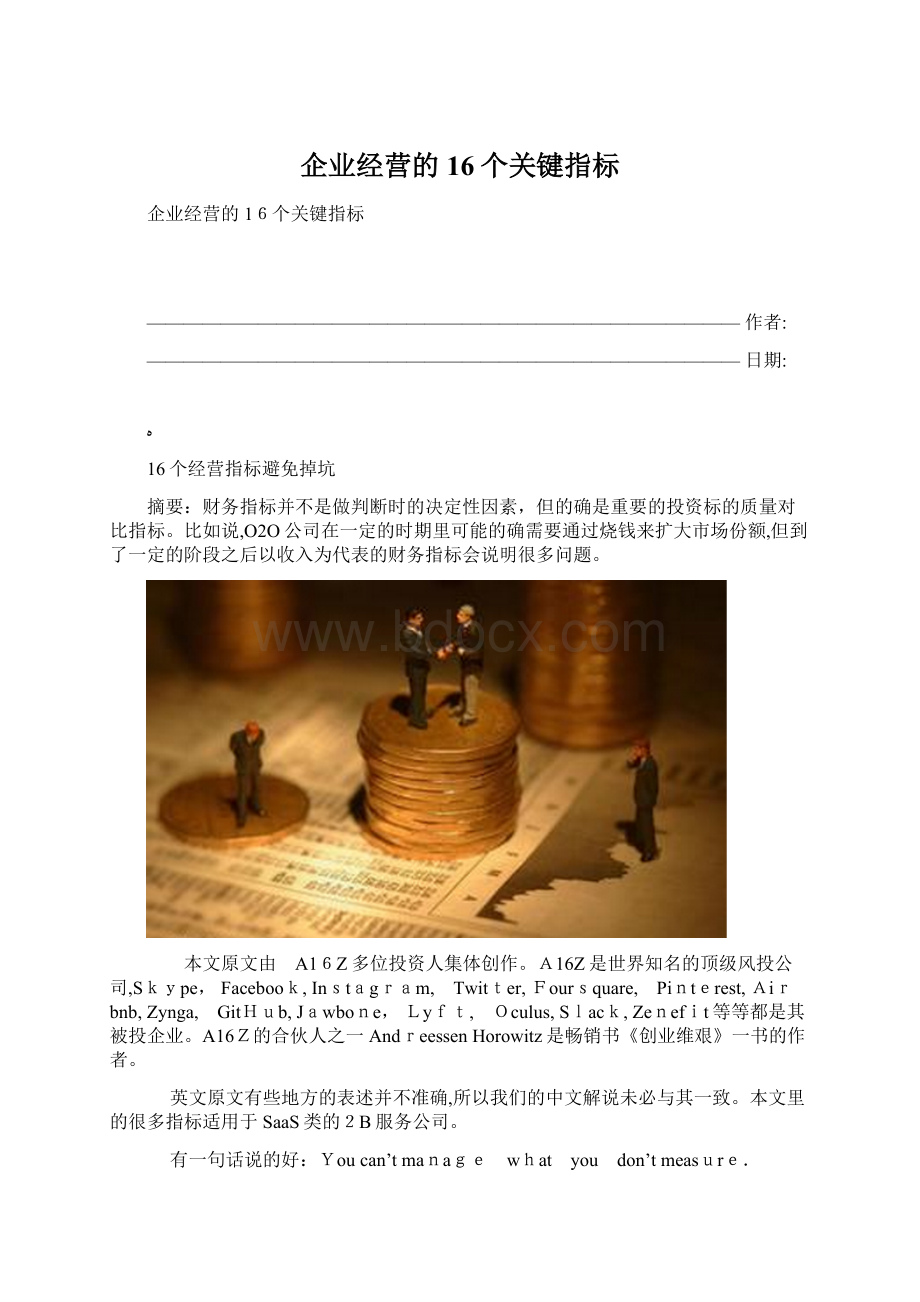 企业经营的16个关键指标Word文档下载推荐.docx
企业经营的16个关键指标Word文档下载推荐.docx
- 文档编号:20879146
- 上传时间:2023-01-26
- 格式:DOCX
- 页数:15
- 大小:221.46KB
企业经营的16个关键指标Word文档下载推荐.docx
《企业经营的16个关键指标Word文档下载推荐.docx》由会员分享,可在线阅读,更多相关《企业经营的16个关键指标Word文档下载推荐.docx(15页珍藏版)》请在冰豆网上搜索。

本文里的很多指标适用于SaaS类的2B服务公司。
有一句话说的好:
Youcan’tmanage what you don’tmeasure.
我们看到各种各样的初创企业,似乎大家都拿到了钱而且活的不错。
但,真实情况是怎样的?
其实需要回答的问题是:
如何衡量一家初创企业的真实情况?
一篇文章很难说清楚这件事,我们只能粗略说一下用来衡量真实情况可能会用到的工具。
具体运用需要区分行业、运营模式、业务发展阶段并结合未来战略布局才有价值。
本文分为三部分:
A)业务与财务指标;
B)产品与用户指标;
C)指标的展示形式
在使用它们时:
首先,使用者需要知道应该选择哪个指标,这需要根据业务的实质来进行选择;
其次,使用者要明白所使用的指标背后所代表的真实情况是什么,这包括过去、现在和未来的情况;
最后,使用者根据指标所反映的真实情况决定进一步的投资、战略或者运营动作。
这里,“使用者”基本上指的是(潜在)投资人和创业公司的管理层。
Wehave theprivilegeofmeeting withthousandsof entrepreneurseveryyear,andinthe courseof thosediscussionsarepresentedwithallkindsofnumbers,measures,and metricsthatillustratethe promise andhealth ofaparticularcompany. Sometimes,however,themetricsmay not bethebestgauge ofwhat’sactuallyhappeninginthebusiness, orpeople may use different definitionsofthesamemetric inawaythatmakesithardtounderstand the healthof thebusiness.
So, whilesomeof thismay beobvious to manyofyouwholiveand breathethesemetricsalldaylong,wecompiledalist ofthemostcommon orconfusing ones.Whereappropriate,wetried to addsomenotesonwhyinvestorsfocuson thosemetrics.Ultimately, though,good metricsaren’taboutraisingmoneyfromVCs—they’reaboutrunningthebusinessin awaywherefounders knowhowandwhycertain thingsareworking(ornot)…andcanaddressor adjustaccordingly.
第一部分:
业务与财务指标
对于多数早期创业公司而言,财务指标并不是做判断时的决定性因素,但的确是重要的投资标的质量对比指标。
比如说,O2O公司在一定的时期里可能的确需要通过烧钱来扩大市场份额,但到了一定的阶段之后以收入为代表的财务指标会说明很多问题。
很多人并不清楚业务数字和财务数字之间的差别。
两者的区别非常清楚,不可混淆。
财务数字是在会计的语言体系下对公司过去业务成果进行的描述。
要对公司的实际情况加以了解,财务和业务数字的互相印证是不可缺少的。
第一、签约合同金额vs.收入(Bookingsvs.Revenue)
我们可以把booking理解为签约记录。
在一个会计期间(通常为一年)里跟谁签了销售合同,合同的签约金额是多大,公司会拿个小本本记录(book)下来。
在把这些签约金额累加在一起之后就构成了本年度公司记录的新签约合同金额(bookings)。
它并不属于会计概念,这个数字过于粗糙,对于分析公司的真实情况通常没有太大的借鉴意义。
收入(Revenue)则是按照会计准则对合同金额进行确认并计量的会计要素。
按照会计语言的定义,收入是指企业在日常活动中所形成的、会导致所有者权益增加的、非所有者投入资本的经济利益的总流入。
一般而言,收入只有在经济利益很可能流入从而导致企业资产增加或者负债减少,且经济利益的流入额能够可靠计量时才能予以确认。
之所以这样规定是为了满足财务报表的谨慎性原则,尽量减少夸大公司业务优势对投资者形成的决策误导。
收入是企业经济利益流入的主要入口。
看收入的绝对值和增长率是投资人最初要看的数字之一。
这个指标本身有其内涵,但在一开始只能起到一个过滤器的作用,对于变现模式清晰的公司,如果收入表现不达标是很少会有人会继续分析的。
另外,稍微普及一下,会计要素一共有6个,分别是利润表里的收入、费用、利润和资产负债表里的资产、负责和所有者权益。
会计准则对于这些要素的确认和计量方式都有明确的规定。
Acommonmistakeistousebookingsandrevenueinterchangeably,but theyaren’t the samething.
Bookingsisthe valueofacontractbetweenthecompanyandthecustomer.It reflectsa contractualobligation on thepartofthecustomerto paythecompany.
Revenueisrecognizedwhentheserviceisactually providedor ratablyover thelifeofthesubscriptionagreement. Howand whenrevenueisrecognizedis governedbyGAAP.
Lettersofintent andverbalagreementsareneither revenuenorbookings.
第二、经常性收入vs.总收入(RecurringRevenuevs.Total Revenue)
Recurring的字面意思是“重复出现的”,我们可以将其理解为由日常业务产生的经常性收入。
这个财务指标衡量的是一家公司的常规业务创造经济利益流入的能力。
在投资人进行财务尽职调查时,非经常性收入通常都是会被剔除在外的。
典型的非经常性收入包括资产处置、资产盘盈、补贴收入、税收优惠、有失公允的关联交易等等。
A16Z的投资人在此提出了三个经常性收入指标:
1)ARR(年度经常性收入)是做业务分析时最基本的经常性收入指标,它是名副其实的“主营业务收入”。
2)ARRper customer(单个用户ARR)衡量的是从单个用户身上获取的年度经常性收入。
分析时可以对用户区分类别,看不同类别单个用户ARR同比/环比变动情况。
这可以判断对单个用户进行upselling(向上销售,在基础销售项目上销售升级版产品)或cross-selling(交叉销售,提供与被销售项目相关的其他销售项目)的效果。
3)MRR(月度经常性收入)是以月度为频率的经常性收入,它是对SaaS公司进行业务分析时的重要指标。
需要注意的地方有,不要把非经常性收入算进来;
不要把合同金额当成收入。
Investorsmorehighlyvalue companieswhere themajorityoftotalrevenuecomes fromproductrevenue (vs. fromservices).Why?
Servicesrevenueisnon-recurring,hasmuchlowermargins, andislessscalable.Productrevenueisthewhatyou generate from thesaleofthesoftwareor productitself.
ARR(annualrecurringrevenue)is ameasureof revenuecomponents thatare recurringin nature.Itshouldexcludeone-time (non-recurring)feesandprofessionalservicefees.
ARR percustomer:
Isthisflator growing?
Ifyouareup-selling or cross-sellingyourcustomers,thenitshouldbe growing, whichis apositiveindicatorforahealthybusiness.
MRR(monthlyrecurringrevenue):
Often,peoplewill multiplyone month’sall-in bookingsby12to gettoARR.Commonmistakes withthis methodinclude:
(1) countingnon-recurringfeessuchas hardware, setup, installation,professionalservices/ consulting agreements;
(2) counting bookings(see #1).
第三、毛利润(Gross Profit)
毛利润=销售收入-销售成本。
毛利润(率)衡量了主营业务在发生期间费用之前的销售获利水平。
在确定毛利润的过程中,最重要的是需要把销售成本的组成部分拎清楚。
销售成本内所包含的成本项目是和销售商品及提供服务直接相关的成本项目。
在看销售成本组成时,需要注意的是公司在进行料工费的分配时是否符合会计上“制造成本”法的要求。
通常,制造业的毛利率会偏低,而软件、快消品行业的毛利率保守的讲也至少在60%以上。
实际上,投资人在进行财务指标衡量时未必是严格按照会计规定进行项目调整的,行业惯例及其所反映的经济实质才是做报表调整背后的原因。
While top-linebookings growth issuper important,investorswant tounderstandhow profitablethatrevenuestreamis.Grossprofit providesthatmeasure.
What’sincludedin grossprofit mayvarybycompany,butin general allcosts associatedwiththemanufacturing,delivery,andsupport ofaproduct/serviceshouldbeincluded.
Sobe preparedto break downwhat’s includedin—andexcluded— fromthat gross profitfigure.
第四、合同总价值vs.年度合同价值(TotalContractValue (TCV)vs.AnnualContractValue(ACV))
合同总价值(TCV),指的是一份商业合同的签约金额,无论合同的服务期限是一个月、几个月或长于一年。
年度合同价值(ACV),指的是经过年化处理后的合同金额。
通常而言,会以单个用户的平均ACV对销售能力和用户的接受度进行分析。
这是SaaS业务的常用分析指标。
需要指出的是,对ACV的分析不能离开下文提到的CAC(获客成本)分析,这两者结合在一起才能看出业务的优劣。
TCV (totalcontractvalue)is thetotalvalueofthecontract,andcan beshorterorlongerinduration.Make sureTCValso includesthevaluefromone-timecharges,professionalservicefees,andrecurringcharges.
ACV(annualcontract value),on the otherhand,measuresthevalueofthe contractovera12-monthperiod.Questionsto askabout ACV:
What isthe size?
Areyougetting a fewhundred dollarsper monthfromyour customers, or areyou abletocloselarge deals?
Ofcourse,thisdependson themarketyou are targeting (SMBvs.mid-market vs. enterprise).
Isitgrowing (and especially notshrinking)?
Ifit’sgrowing,itmeanscustomers arepayingyou moreonaverageforyourproductover time.That implieseitheryour productisfundamentallydoingmore(addingfeaturesandcapabilities) towarrantthatincrease,orisdelivering somuchvalue customers (improvedfunctionality overalternatives)thattheyarewillingtopaymoreforit.
第五、获客成本/ CAC (CustomerAcquisitionCost) … (Blendedvs.Paid,Organicvs.Inorganic)
获客成本(CAC)这一项在原文中是第八条,由于它的重要性,我们将其提前至第五条。
CAC是获取单个新用户所需花费的全部成本。
其计算公式为:
CAC=销售费用总额/期间新增用户数。
在确定CAC时,总体上要遵循谨慎性原则:
首先,需要遵循完整性原则把在经济实质上归属于获取新客户的所有费用都包括进来(销售行为中的打折、返点都属于此类)。
其次,必须将来自不同渠道的新客户进行区分。
来自不同渠道的用户所对应的CAC可能是不同的。
另外,因为总会有一部分用户是自己找过来而不是通过你的市场投入吸引过来的,这一类用户不可以进入CAC计算公式的分母项。
所以,严格意义上的CAC是所谓的paidCAC,即,通过付出市场费用而获取的用户所对应的CAC。
把来自不同获客渠道的用户所对应的ARR和paidCAC进行对比可以看出特定类别用户的利润贡献度以及市场投入的可行性。
另外,对特定市场渠道加大投入可能会引起该渠道paid CAC的变化,其变化情况和背后的原因可能非常重要。
CustomeracquisitioncostorCAC should bethefullcost ofacquiringusers,statedon aperuserbasis. Unfortunately,CAC metricscomeinallshapes andsizes.
OnecommonproblemwithCACmetricsisfailing to includeallthecosts incurredin useracquisition such asreferralfees, credits,ordiscounts.Anothercommon problemis tocalculate CACasa“blended”cost(includingusers acquiredorganically)ratherthanisolatingusers acquiredthrough“paid” marketing.Whileblended CAC[totalacquisition cost /totalnewcustomersacquiredacrossallchannels]isn’t wrong, it doesn’tinform howwellyourpaid campaigns areworkingandwhether they’reprofitable.
Thisis whyinvestorsconsiderpaidCAC[totalacquisitioncost/newcustomersacquiredthroughpaidmarketing]tobemore important thanblendedCAC in evaluatingthe viability ofa business—it informs whether acompanycan scaleupitsuseracquisition budgetprofitably.While an argumentcan bemadeinsomecasesthatpaid acquisitioncontributesto organicacquisition,onewouldneedtodemonstrateproofofthateffect toputweightonblended CAC.
Many investorsdolike seeingboth,however:
theblendednumberaswellas theCAC,brokenout bypaid/unpaid.Wealso likeseeingthebreakdownbydollars of paidcustomer acquisitionchannels:
for example,how muchdoesapayingcustomer costif theywereacquiredviaFacebook?
Counterintuitively,itturns outthatcoststypicallygoupasyoutryandreacha larger audience. So itmight cost you$1toacquireyour first1,000users,$2 toacquireyour next 10,000,and$5to$10 toacquireyournext100,000. That’swhyyoucan’taffordtoignorethemetricsaboutvolumeof usersacquiredviaeachchannel.
第六、用户生命周期总价值/LTV(LifeTimeValue)
严格来讲,LTV的定义是:
特定用户对公司贡献的未来所有期间净利润的现值。
现值是一个财务管理上的概念,简单的讲,未来的钱没有现在的钱值钱,所以,折现就是要把未来经济利益的面值折算成为现在的价值。
我们不在此向读者具体展示和说明LTV的计算公式,仅仅说明一下LTV的用途以及需要注意的事项。
对于初创企业,LTV的主要用途是用于衡量公司(特别是SaaS公司)市场支出的有效性并用以决定是否需要进入加速扩大市场支出的阶段。
理想而言,SaaS公司LTV/CAC的经验比率数字应该大于3。
与LTV相关的因素主要有:
ARPU(平均单个用户收入)、用户流失率(其倒数为用户生命周期)、服务单个用户成本、CAC(获客成本)。
这几个因素之间是相互影响的,它们的背后实质是公司行为和用户行为之间的互动结果。
因此,在计算LTV时所使用的假设应该是基于业务实际情况进行的谨慎且合理的推断。
投资人和管理层的出发点在有些时候可能不同,投资人需要减少风险,创业者需要加大投入推进业务。
这就造成大家所使用的假设可能不同,假设的合理性与否就要看各自的职业判断能力了。
实际上,计算LTV并不需要得到特别精确的数字,只要平衡谨慎性和合理性原则对各个参数进行假设得到有价值的决策结果即可。
Lifetime valueis thepresentvalueofthe futurenet profitfromthe customerovertheduration of therelationship. Ithelpsdeterminethelong-termvalueofthe customer andhow much net value yougenerate percustomerafteraccountingfor customeracquisitioncosts (CAC).
Acommon mistake istoestimate theLTVasa presentvalueofrevenueoreven grossmar
- 配套讲稿:
如PPT文件的首页显示word图标,表示该PPT已包含配套word讲稿。双击word图标可打开word文档。
- 特殊限制:
部分文档作品中含有的国旗、国徽等图片,仅作为作品整体效果示例展示,禁止商用。设计者仅对作品中独创性部分享有著作权。
- 关 键 词:
- 企业 经营 16 关键 指标
 冰豆网所有资源均是用户自行上传分享,仅供网友学习交流,未经上传用户书面授权,请勿作他用。
冰豆网所有资源均是用户自行上传分享,仅供网友学习交流,未经上传用户书面授权,请勿作他用。


 对中国城市家庭的教育投资行为的理论和实证研究.docx
对中国城市家庭的教育投资行为的理论和实证研究.docx
